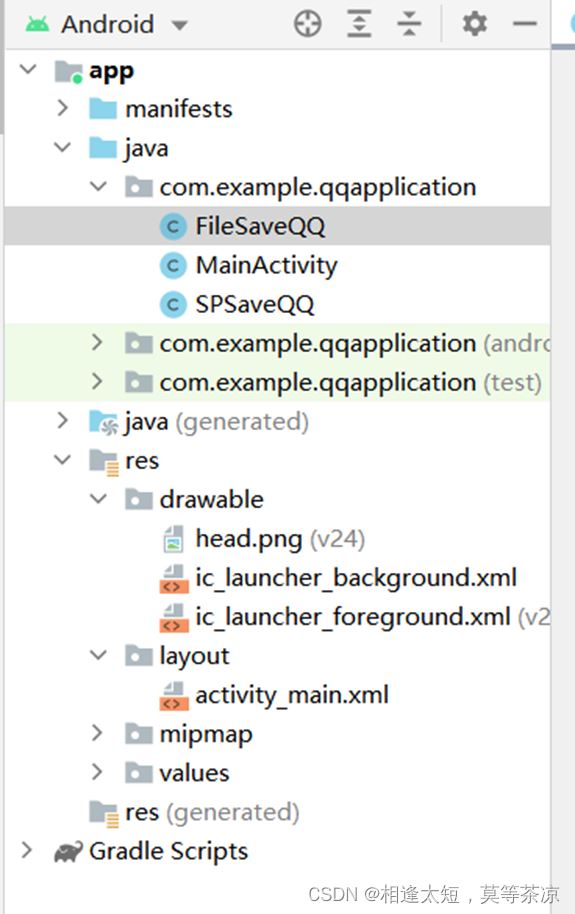android文件存储和SharedPreferences存储的项目实例
该实例为课程作业,请尊重劳动成果。
演示

【文件存储】中查看设备保存的文件

目录

activity_main
<?xml version="1.0" encoding="utf-8"?>
<LinearLayout xmlns:android="http://schemas.android.com/apk/res/android"
xmlns:app="http://schemas.android.com/apk/res-auto"
xmlns:tools="http://schemas.android.com/tools"
android:layout_width="match_parent"
android:layout_height="match_parent"
android:background="#E6E6E6"
android:orientation="vertical"
android:padding="10dp"
tools:context=".MainActivity">
<ImageView
android:layout_width="70dp"
android:layout_height="70dp"
android:layout_centerHorizontal="true"
android:layout_gravity="center_horizontal"
android:layout_marginTop="30dp"
android:src="@drawable/head" />
<LinearLayout
android:layout_width="match_parent"
android:layout_height="wrap_content"
android:layout_marginTop="15dp"
android:background="@android:color/white"
android:orientation="horizontal">
<TextView
android:layout_width="wrap_content"
android:layout_height="wrap_content"
android:padding="10dp"
android:text="账号:"
android:textColor="#000"
android:textSize="20sp" />
<EditText
android:id="@+id/et_account"
android:layout_width="match_parent"
android:layout_height="wrap_content"
android:layout_marginLeft="5dp"
android:background="@null"
android:padding="10dp" />
</LinearLayout>
<LinearLayout
android:layout_width="match_parent"
android:layout_height="wrap_content"
android:layout_marginTop="10dp"
android:background="@android:color/white"
android:orientation="horizontal">
<TextView
android:id="@+id/tv_password"
android:layout_width="wrap_content"
android:layout_height="wrap_content"
android:padding="10dp"
android:text="密码:"
android:textColor="#000"
android:textSize="20sp" />
<EditText
android:id="@+id/et_password"
android:layout_width="match_parent"
android:layout_height="wrap_content"
android:layout_marginLeft="5dp"
android:background="@null"
android:inputType="textPassword"
android:padding="10dp" />
</LinearLayout>
<Button
android:id="@+id/btn_login"
android:layout_width="match_parent"
android:layout_height="wrap_content"
android:layout_marginTop="25dp"
android:background="#3C8DC4"
android:text="登录"
android:textColor="@android:color/white"
android:textSize="20sp" />
</LinearLayout>
MainActivity
/**
* 文件存储和SharedPreferences存储实例
*/
public class MainActivity extends AppCompatActivity {
private EditText et_account, et_password; //账号输入框、密码输入框
private Button loginBtn; //登录按钮
@Override
protected void onCreate(Bundle savedInstanceState) {
super.onCreate(savedInstanceState);
setContentView(R.layout.activity_main);
initView();
}
private void initView() {
et_account = findViewById(R.id.et_account);
et_password = findViewById(R.id.et_password);
loginBtn = findViewById(R.id.btn_login);
//点击监听事件
loginBtn.setOnClickListener(new View.OnClickListener() {
@Override
public void onClick(View view) {
switch (view.getId()) {
case R.id.btn_login:
//当点击登录按钮时,获取界面上输入的 QQ 账号和密码
String account = et_account.getText().toString().trim();
String password = et_password.getText().toString();
//检验输入的账号和密码是否为空
if (TextUtils.isEmpty(account)) {
Toast.makeText(getApplicationContext(), "请输入 QQ 账号", Toast.LENGTH_SHORT).show();
return;
}
if (TextUtils.isEmpty(password)) {
Toast.makeText(getApplicationContext(), "请输入密码", Toast.LENGTH_SHORT).show();
return;
}
//文件存储
//saveOfFile(account,password);
//SharedPreferences存储
saveOfSharedPreferences(account,password);
break;
}
}
});
}
//SharedPreferences存储
private void saveOfSharedPreferences(String account, String password) {
//获取 QQ 账号和密码信息
SharedPreferences userInfo=SPSaveQQ.getUserInfo(getApplicationContext());
if (userInfo.getString("username", "") != null&&userInfo.getString("pwd", "") != null) {
String username = userInfo.getString("username", "");//读取账号
String pwd = userInfo.getString("pwd", "");//读取密码
Log.i("user", "读取用户信息");
Log.i("user", "username:" + username + ", pwd:" + pwd);
if (username.equals(account) && pwd.equals(password)) {
Toast.makeText(getApplicationContext(), username+"登录成功!", Toast.LENGTH_SHORT).show();
}else {
Log.i("user", "用户或密码错误!");
//保存用户信息
boolean isSaveSuccess = SPSaveQQ.saveUserInfo(getApplicationContext(), account, password);
if (isSaveSuccess) {
Toast.makeText(getApplicationContext(), "保存成功!", Toast.LENGTH_SHORT).show();
} else {
Toast.makeText(getApplicationContext(), "保存失败!", Toast.LENGTH_SHORT).show();
}
}
}else{
//保存用户信息
boolean isSaveSuccess = SPSaveQQ.saveUserInfo(getApplicationContext(), account, password);
if (isSaveSuccess) {
Toast.makeText(getApplicationContext(), "保存成功!", Toast.LENGTH_SHORT).show();
} else {
Toast.makeText(getApplicationContext(), "保存失败!", Toast.LENGTH_SHORT).show();
}
}
}
//文件存储
private void saveOfFile(String account, String password) {
//获取 QQ 账号和密码信息
Map<String, String> userInfo = FileSaveQQ.getUserInfo(getApplicationContext());
if (userInfo != null) {
//将获取的账号显示到界面上
et_account.setText(userInfo.get("account"));
//将获取的密码显示到界面上
et_password.setText(userInfo.get("password"));
Toast.makeText(getApplicationContext(), userInfo.get("account")+"登录成功!", Toast.LENGTH_SHORT).show();
}else{
//保存用户信息
boolean isSaveSuccess = FileSaveQQ.saveUserInfo(getApplicationContext(), account, password);
if (isSaveSuccess) {
Toast.makeText(getApplicationContext(), "保存成功!", Toast.LENGTH_SHORT).show();
} else {
Toast.makeText(getApplicationContext(), "保存失败!", Toast.LENGTH_SHORT).show();
}
}
}
}
FileSaveQQ
/**
* 实现 QQ 账号与密码的文件存取与读取功能
*/
public class FileSaveQQ {
/**
* 保存用户信息
* @param context
* @param account 账号
* @param password 密码
* @return
*/
public static boolean saveUserInfo(Context context, String account, String password) {
//文件的输出流对象
FileOutputStream fos = null;
try {
//获取文件的输出流对象 fos,该文件只能被当前程序读写
fos = context.openFileOutput("user.txt",
Context.MODE_PRIVATE);
//将数据转换为字节码的形式写入 user.txt 文件中
fos.write((account + ":" + password).getBytes());
return true;
} catch (Exception e) {
e.printStackTrace();
return false;
}finally {
try {
if(fos != null){
fos.close();
}
} catch (IOException e) {
e.printStackTrace();
}
}
}
/**
* 从 user.txt 文件中获取存储的用户信息
* @param context
* @return
*/
public static Map<String, String> getUserInfo(Context context) {
String content = "";
//文件的输入流对象
FileInputStream fis = null;
try {
//获取文件的输入流对象 fis
fis = context.openFileInput("user.txt");
//将输入流对象中的数据转换为字节码的形式
byte[] buffer = new byte[fis.available()];
//通过 read()方法读取字节码中的数据
fis.read(buffer);
//将获取的字节码转换为字符串
content = new String(buffer);
Map<String, String> userMap = new HashMap<String, String>();
String[] infos = content.split(":");
//放入账号密码
userMap.put("account", infos[0]);
userMap.put("password", infos[1]);
Log.i("user", "读取用户信息");
Log.i("user", "account:" + infos[0] + ", password:" + infos[1]);
return userMap;
} catch (Exception e) {
e.printStackTrace();
return null;
} finally {
try {
if (fis != null) {
fis.close();
}
} catch (IOException e) {
e.printStackTrace();
}
}
}
}
SPSaveQQ
/**
* 实现 QQ 账号与密码SharedPreferences的存取与读取功能
*/
public class SPSaveQQ {
/**
* 保存用户信息
*/
public static boolean saveUserInfo(Context context, String account, String password){
SharedPreferences sharedPreferences = null;
try {
sharedPreferences = context.getSharedPreferences("user", Context.MODE_PRIVATE);
SharedPreferences.Editor editor = sharedPreferences.edit();//获取编辑器
editor.putString("username", account);
editor.putString("pwd", password);
editor.commit();//提交修改
return true;
}catch (Exception e){
e.printStackTrace();
return false;
}finally {
if(sharedPreferences != null){
return true;
}
return false;
}
}
/**
* 读取用户信息
*/
public static SharedPreferences getUserInfo(Context context){
SharedPreferences userInfo = context.getSharedPreferences("user", Context.MODE_PRIVATE);
return userInfo;
}
}
到此这篇关于android文件存储和SharedPreferences存储的项目实例的文章就介绍到这了,更多相关android文件存储和SharedPreferences存储内容请搜索我们以前的文章或继续浏览下面的相关文章希望大家以后多多支持我们!
赞 (0)

